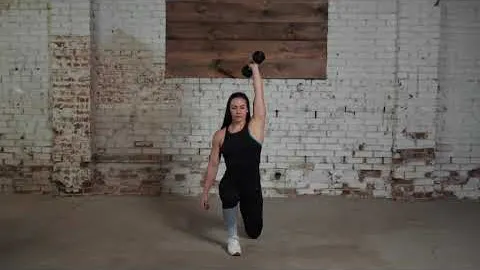
The Single Arm Overhead Lunge is an excellent exercise that targets multiple muscle groups while promoting core stability and overall strength. It is a challenging movement that combines a lunge with an overhead arm extension, providing a full-body workout. This exercise is not only effective for building muscle and improving balance, but it also enhances functional movement patterns necessary for daily activities and athletic performance.
Muscle Activation: The Single Arm Overhead Lunge engages a variety of muscles throughout the body. The primary muscles targeted include the quadriceps, glutes, hamstrings, and calves. Additionally, muscles in the upper body, such as the deltoids, trapezius, and triceps, are engaged to stabilize and control the movement.
Core Stability: As you perform the Single Arm Overhead Lunge, your core muscles must engage to maintain balance and stability. This exercise challenges both the deep stabilizing muscles and the superficial muscles of the core, resulting in improved overall core strength and stability.
Functional Movement: The Single Arm Overhead Lunge mirrors many movements we perform in daily life, such as reaching for objects overhead or stepping forward. By training these movements, you are enhancing your body's ability to move efficiently and safely in a functional manner.
Balance and Coordination: The Single Arm Overhead Lunge requires a high degree of balance and coordination. By practicing this exercise regularly, you can improve your ability to stabilize and control your body while performing various movements, reducing the risk of falls and injuries.
Starting Position: Begin by standing upright with your feet hip-width apart. Hold a dumbbell or kettlebell in one hand, with your palm facing inward towards your body. Engage your core muscles to stabilize your torso.
Lunge: Take a step forward with one leg, keeping your core engaged and your torso upright. As you step forward, lower your body into a lunge position by bending your knees. Ensure that your front knee is directly above your ankle and that your back knee is hovering slightly above the ground.
Overhead Arm Extension: As you lower into the lunge, simultaneously extend your arm with the weight overhead. Keep your elbow straight, and fully extend your arm so that the weight is directly above your head. Maintain a strong and stable core throughout the movement.
Return to Starting Position: Push through your front foot and drive your body back up to the starting position, lifting your back leg off the ground. Lower the weight back down to the starting position and repeat the movement on the opposite leg.
Repeat: Perform the Single Arm Overhead Lunge for a desired number of repetitions on each leg. Start with a weight that challenges you but allows you to maintain proper form. As you become stronger and more comfortable, you can gradually increase the weight.
The Single Arm Overhead Lunge can be incorporated into your training routine as part of a full-body workout or as a targeted exercise for specific muscle groups. Here are some suggestions on how to include this exercise in your routine:
Full-Body Workout: Perform the Single Arm Overhead Lunge as part of a circuit or superset with other exercises such as squats, push-ups, and rows. Alternate between upper body, lower body, and core exercises for a well-rounded workout.
Leg Day Routine: Incorporate the Single Arm Overhead Lunge into your leg day routine to target and strengthen the quadriceps, glutes, and hamstrings. Pair it with other leg exercises like deadlifts, lunges, and calf raises for a comprehensive lower body workout.
Core Strengthening: Use the Single Arm Overhead Lunge as a core-strengthening exercise by focusing on maintaining a stable core throughout each repetition. Include it in a circuit or combine it with other core exercises such as planks, Russian twists, and stability ball exercises.
As with any exercise, it is important to prioritize safety and listen to your body. Here are some safety considerations to keep in mind when performing the Single Arm Overhead Lunge:
In conclusion, the Single Arm Overhead Lunge is a highly effective exercise for targeting multiple muscle groups, promoting core stability, improving functional movement, and enhancing balance and coordination. By incorporating this exercise into your training routine, you can achieve a stronger, more stable, and functionally capable body. Remember to prioritize safety and proper form to maximize the benefits and minimize the risk of injury.
If you're looking for a gym, fitness club or yoga studio, you've come to the right place.
You can find information about gyms in your area. Browse catalog of gyms and find gyms with classes which are you looking for.
On gym page you can find simple information like address, phone or website. You can find list of available classes. You can check availability of personal training or small group classes. On place page you can also see information about open hours.
You can find gyms near you with amenities, courts, studios and equipments.
Use our map to find gym at your city or district.
In Gym Navigator you can find list of exercises with movies for many body parts.
You can browse exercises catalog and find exercises the best of you.
You can also find exercises grouped into workout plans, which you can use to improve you body. Each routine show you exercises one by one and give you possibility to count you progress and count down rest time.